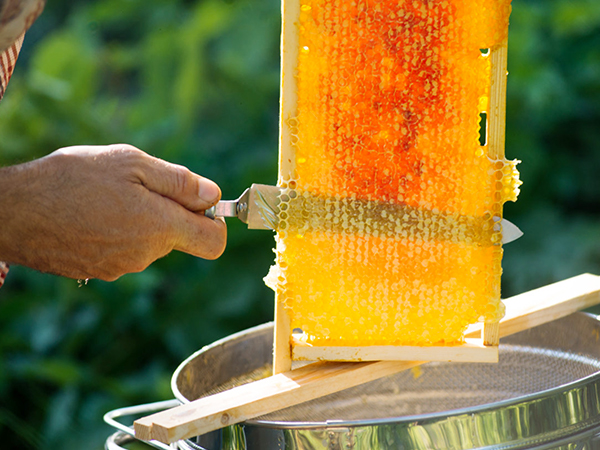Extracting honey at home can be a rewarding process, but it requires some careful steps to ensure a safe and clean harvest. Here’s a general guide on how to extract honey at home:
Equipment You’ll Need:
- Beehive with Honey Supers: Ensure that the bees have capped the honey in the frames you plan to harvest.
- Beekeeping Suit and Accessories: Wear protective gear, including a beekeeping suit, gloves, and a veil to avoid stings.
- Bee Smoker: Use a bee smoker to calm the bees before opening the hive.
- Bee Brush: Gently brush the bees off the frames before removing them.
- Hive Tool: Use a hive tool to pry apart the hive components.
- Uncapping Knife or Scratcher: This is used to remove the wax cappings from the honeycomb.
- Uncapping Tank or Tray: Collect the wax cappings for later processing.
- Honey Extractor: This machine spins the frames to extract honey.
- Food-Grade Buckets or Containers: To collect and store the honey.
- Strainer or Sieve: To filter out impurities like wax and bee parts.
- Honey Jars: Clean and dry jars for storing the extracted honey.
Harvesting Process:
- Prepare the Workspace:
- Choose a clean and well-lit area for honey extraction.
- Set up your equipment in an organized manner.
- Collect Frames:
- Use the bee smoker to calm the bees.
- Gently remove frames from the honey supers.
- Uncap the Frames:
- Use an uncapping knife or scratcher to remove the wax cappings from both sides of the frames.
- Collect the cappings in an uncapping tank or tray.
- Extract Honey:
- Place the uncapped frames in the honey extractor.
- Spin the frames to extract honey. The centrifugal force separates honey from the comb.
- Filtering:
- Pour the extracted honey through a strainer or sieve to remove debris and wax particles.
- Bottling:
- Pour the filtered honey into clean and dry jars.
- Leave some headspace at the top of the jars to account for expansion.
- Labeling:
- Label your honey jars with the date and any other relevant information.
- Clean Up:
- Clean all equipment thoroughly to prevent the spread of diseases among the bees.
Tips and Precautions:
- Work slowly and deliberately to avoid disturbing the bees excessively.
- Harvest honey when most of the cells in the frames are capped, indicating that the honey is mature.
- Avoid harvesting too much honey, leaving enough for the bees to survive through the winter.
- Respect local regulations and guidelines for beekeeping.
Before attempting to extract honey, it’s crucial to educate yourself about beekeeping practices and ensure that you have the necessary equipment and protective gear. Additionally, consider seeking guidance from experienced beekeepers or local beekeeping associations.

